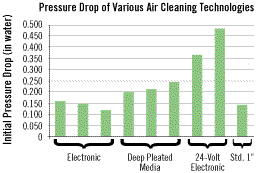
Add to this picture the rapid growth of air cleaner sales in the retail sector. Virtually nonexistent before 1985, this retail market quickly caught up to — then roared past — air cleaners sold through trade channels. Last year, U.S. manufacturers sold retailers over $200 million worth of portable air cleaners.
Meanwhile, hvac channel sales of whole-house air cleaners trail far behind at $85 million a year. This figure includes sales of professionally installed media and electronic whole-house air cleaners.
Worth noting is that the retail industry has focused on the high-efficiency message of the popular HEPA filters, which are 99.97% efficient in capturing 0.3 micron-sized particles from the air that passes through the filter. In contrast, much of the trade channel has emphasized lower-efficiency media filters, virtually all of which are less than 20% efficient at capturing 0.3 micron-sized particles. Confusing matters frequently on the trade side is the presumption that there’s not much difference in performance between the various whole-house air cleaner technologies.
Understanding the performance differences between air cleaner technologies and the health problems associated with small airborne particles can help you better serve your customers’ needs and can give your business a profit boost. Add-on sales of whole-house air cleaners (and other home comfort accessories) can significantly boost profit margins for contractors.

Small Particles, Big Concerns
EPA studies indicate that indoor air levels of many pollutants may be two to five times, and occasionally more than 100 times, higher than outdoor levels. In 1997, the EPA added new particulate standards that set more stringent goals for fine particles in the air. Based on a review of recent scientific studies, the agency found that “it is the smaller (or fine) particles — less than 2.5 microns in diameter — that are largely responsible for the health effects of greatest concern.” This is because these smaller particles easily reach the deepest recesses of the lungs, according to the EPA.Scientific studies have linked particulate matter (alone or with other air pollutants) to a series of significant health problems, including respiratory-related hospital admissions and emergency room visits, aggravated asthma, acute respiratory symptoms, including aggravated coughing and difficult or painful breathing, chronic bronchitis, decreased lung function, and work and school absences.
The EPA says that those at greatest risk from exposure to fine particles include the elderly, individuals with preexisting heart or lung disease, children, and asthmatics.
In contrast, particles between 2.5 and 10 microns in diameter do not usually penetrate so deeply into the respiratory tract and upper air passageway. Particles larger than 10 microns are generally not breathed by people during ordinary activities.

Performance Factors
Studies have shown that a high-efficiency air cleaner can significantly reduce household concentrations of respirable particles during periods when occupants are at rest.
The actual air cleaning performance varies greatly among the air filtration technologies. The size and percentage of particles captured depends on the air cleaner technology used and differences in product design and materials. In addition, the performance of an air filtration system in a home depends on the home’s floor plan, duct design, heating-cooling equipment, and other factors. The layout and construction of the forced-air duct system is different in each house and will result in different airflow patterns and particulate concentrations within the house. This can have an effect on the exposure level to respirable particles.
How They Stack Up
Recent tests conducted in the U.S. and Canada offer useful comparisons in the filtration performance for the different air cleaner technologies. Figure 1 illustrates the results of fractional efficiency testing of various air cleaning technologies from several manufacturers. As shown, electronic air cleaners are more efficient against the smallest particles.Figure 2 shows the results of testing different models and filtration technologies for initial pressure drop. Electronic air cleaners lead in low initial pressure drop, while 24-volt electronic filters yield the highest initial resistance to airflow.
In an assessment of residential furnace filters conducted for the Canada Home Mortgage Corporation, researchers tested the effectiveness of air cleaners in reducing respirable particles in the occupied space. The research project rotated several filters through six homes in southern Ontario during the heating season. Particle concentrations were monitored in two interior collection sites, the bedroom and the living room. The study found that particle concentrations varied widely throughout a typical day, with higher levels of particulates in the air during periods of activity in the house, as might be expected. However, a measurable reduction in the mean particle concentrations present in the air in the homes during both active and non-active periods was found when high efficiency air cleaners were installed.
The study found that particle reduction varied widely between air cleaning technologies. Electronic air cleaners showed significantly more reduction in respirable particles — up to a 71% reduction compared to no filter during non-active times such as periods of sleep — than deep-pleated media air cleaners. Ordinary furnace filters do not filter respirable particles, and thus offered no reduction in particle concentrations.
Other factors should be considered when recommending or choosing an air cleaner. What is the filter’s dust-holding capacity? What is the filter’s performance when it is “loaded” with dust? As media filters load with dust, for example, they typically deliver better filtration efficiency, but that efficiency comes at the expense of pressure drop.
Kensok is IAQ product leader for Honeywell Home and Building Control, Golden Valley, MN. For more information, call 1-800-345-6770, or go to www.honeywell.com (website) or info@honeywell.com (e-mail).

Report Abusive Comment